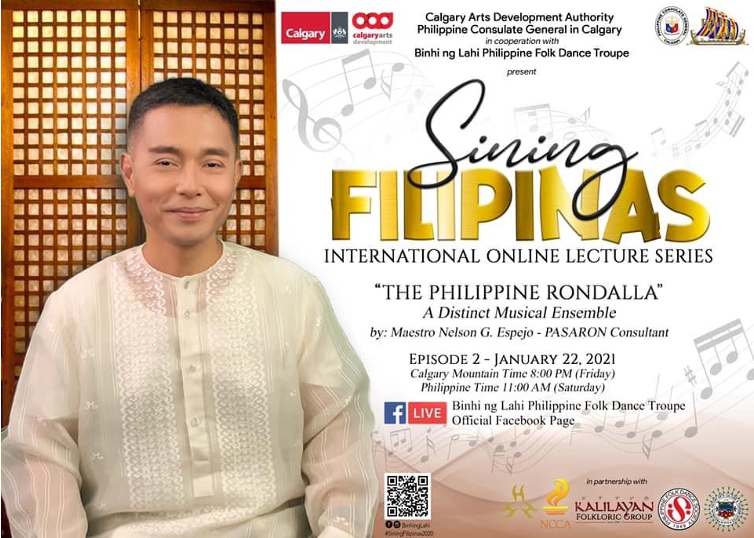
10 February 2021, Calgary – The second episode of “Sining Filipinas,” the seven-part online lecture series on Philippine arts, aired live on 29 January 2021, 8:00 p.m., Calgary time, at the Facebook page of Binhi ng Lahi Philippine Folk Dance Troupe (Binhi).
The episode focused on the Philippine rondalla, a popular string ensemble the Filipinos learned from the Spaniards during Spain’s more than three centuries of colonization of the Philippines. The Filipino rondalla is usually composed of stringed instruments, such as the banduria, octavina, laud, guitar and the bajo de uñas.
The ensemble became popular all over the Philippines under different names, such as murga, comparza, estudiantina, and rondalla. The latter became the catchall term when the popular 1960s DZAQ radio program “Hamon sa Kampeon,” featuring a contest for these Spanish-influenced string ensembles, were always referred to as “rondalla” by hosts Bobby Gonzales and Dely Magpayo, so the episode’s lecturer, Maestro Nelson Espejo of Pambansang Samahan ng Rondalla (PASARON), discussed.
The lecture highlighted the origin of the rondalla from its Spanish introduction, the popular groups during the early America era, and an historical timeline on its major developments from the 1960s to the present when its popularization went on exciting pace courtesy of the support of mass media, such as DZAQ, Taliba Newspaper, and People’s Television (PTV), and concerned government institutions, such as the Cultural Center of the Philippines’ National Music Competition for Young Artists, Inc. (NAMCYA) and Folk Arts Theatre, the Department of Education, and the Department of Interior and Local Government.
From the early ensembles performing folksy melodies for native songs and dances, the rondalla evolved into its more sophisticated form as contests were held for symphonic rondalla composition pieces, which were in turn, interpreted by various rondalla groups, who were also themselves competing against each other. Also, in the past half century, new groups emerged advancing the promotion and the development of the Philippine rondalla. Preeminent among these are the PASARON, the training center for rondalla teachers in Silang, Cavite, the NAMCYA, and the World Rondalla Association.
The lecture also detailed the technical nuances of the rondalla, especially on its classifications as to audio tag, instruments family, and timbre and size.
For its next offering scheduled in February, Sining Filipinas will have Kalilayan Folkloric Group (KFG) founder and Director and authority on sartorial culture of Christianized Philippine people groups, Mr. Rommel Padillo Serrano, who will lecture on Tubong of Catanauan, a traditional cultural activity in the town of Catanauan in Quezon Province, Philippines.
The Sining Filipinas series is sponsored by the Philippine Consulate General in Calgary and the Calgary Arts Development Authority. Event partners are government and private institutions which are among the prime movers in Philippine arts and culture milieu, such as the National Commission for Culture and the Arts, CCP, Philippine Folk Dance Society (PFDS), Bulacan’s Provincial History, Arts, Culture and Tourism Office (PHACTO), the Barangay Dance Company of San Francisco, California, United States of America (BDC), and the KFG of Catanauan, Quezon.
